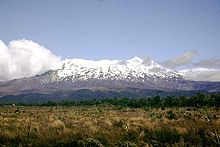Ngāti Rangi or Ngāti Rangituhia is a Māori iwi (tribe) of New Zealand. Contemporary settlement is mainly around Waiouru, Ohakune, and the Upper Whanganui River in the central North Island.[1] The iwi's area of interest extends north from the Paretetaitonga peak of Mount Ruapehu, west to the Pukupuku Stream, east to the meeting of the Moawhango and Aorangi waterways, and south to the Haumakariri Stream.[2] Ngāti Rangi trace their ancestry to Paerangi. They believe they were in New Zealand before the first migrations from Hawaiki.
| Ngāti Rangi | |
|---|---|
| Iwi (tribe) in Māoridom | |
 | |
| Rohe (region) | Central North Island |
| Website | ngatirangi |
In 2015 Ngāti Rangi entered into negotiations with the Crown to settle claims under the Treaty of Waitangi.[3] A deed of settlement was signed in 2018 followed by the passing of the Ngāti Rangi Claims Settlement Bill - Rukutia Te Mana in 2019.[4][5][6] They also commenced negotiations with Genesis Energy in 2010 to manage and restore water flows in rivers from which water had been diverted for the Tongariro Power Scheme.[3]
Ngāti Rangi have been a partner in the conservation programme Kiwi Forever hosting students on their marae to learn about the flora and fauna and tikanga Māori (Māori traditions).[7][8] The iwi received funding from the Government’s Jobs for Nature programme in 2021 to tackle invasive plant and animal pests. The programme would be delivered by the iwi's company Ruapehu WorX.[9]
Pepeha (tribal saying)
editKo Ruapehu te maunga
Ko Ngā Turi o Murimotu te maunga tapu
Ko Whangaehu te awa
Ko Ngāti Rangi te iwi
References
edit- ^ Batley, R.A.L. (1973). "Ngati Rangi: Whiro's family at Murimotu, North Island, New Zealand". Journal of Polynesian Society. 82 (4): 343–354.
- ^ Te Puni Kōkiri. "Ngāti Rangi". Te Kāhui Māngai. Retrieved 2 August 2021.
- ^ a b "NGATI RANGI: Pioneers in Protecting Maori Land Claims". www.culturalsurvival.org. 2017-06-02. Retrieved 2023-11-14.
- ^ "Ngāti Rangi". New Zealand Government. 2018. Retrieved 2023-11-25.
- ^ "Ngāti Rangi signs settlement with the Crown". beehive.govt.nz. 10 March 2018. Retrieved 15 November 2023.
- ^ Kupenga, Talisa (25 July 2019). "Ngāti Rangi settlement bill passes final reading". Te Ao Māori News. Retrieved 2023-11-25.
- ^ "Kiwi Forever conservation and cultural programme". www.doc.govt.nz. 20 April 2018. Retrieved 2023-11-15.
- ^ "Marae conservation programme makes long term impact". Waatea News. 28 March 2023. Retrieved 6 December 2024.
- ^ "Tackling Tongariro's biodiversity threats". beehive.govt.nz. 15 November 2021. Retrieved 15 November 2023.
Further reading
edit- Pardo, Natalia; Wilson, Hildalene; Procter, Jonathan N; Lattughi, Erica; Black, Taiarahia (2015). "Bridging Māori indigenous knowledge and western geosciences to reduce social vulnerability in active volcanic regions". Journal of Applied Volcanology. 4 (1). doi:10.1186/s13617-014-0019-1. ISSN 2191-5040.
- Rāwiri, Āneta Hinemihi, ed. (2009). Mouri tu,̄ mouri ora: water for wisdom and life: Ngāti Rangi, the Tongariro Power Scheme and the Resource Management Act 1991 : reconciling indigenous spiritual wellbeing, corporate profit, and the national interest. Whanganui: Te Atawhai o Te Ao, Independent Māori Institute for Environment and Health. ISBN 9780473146344.